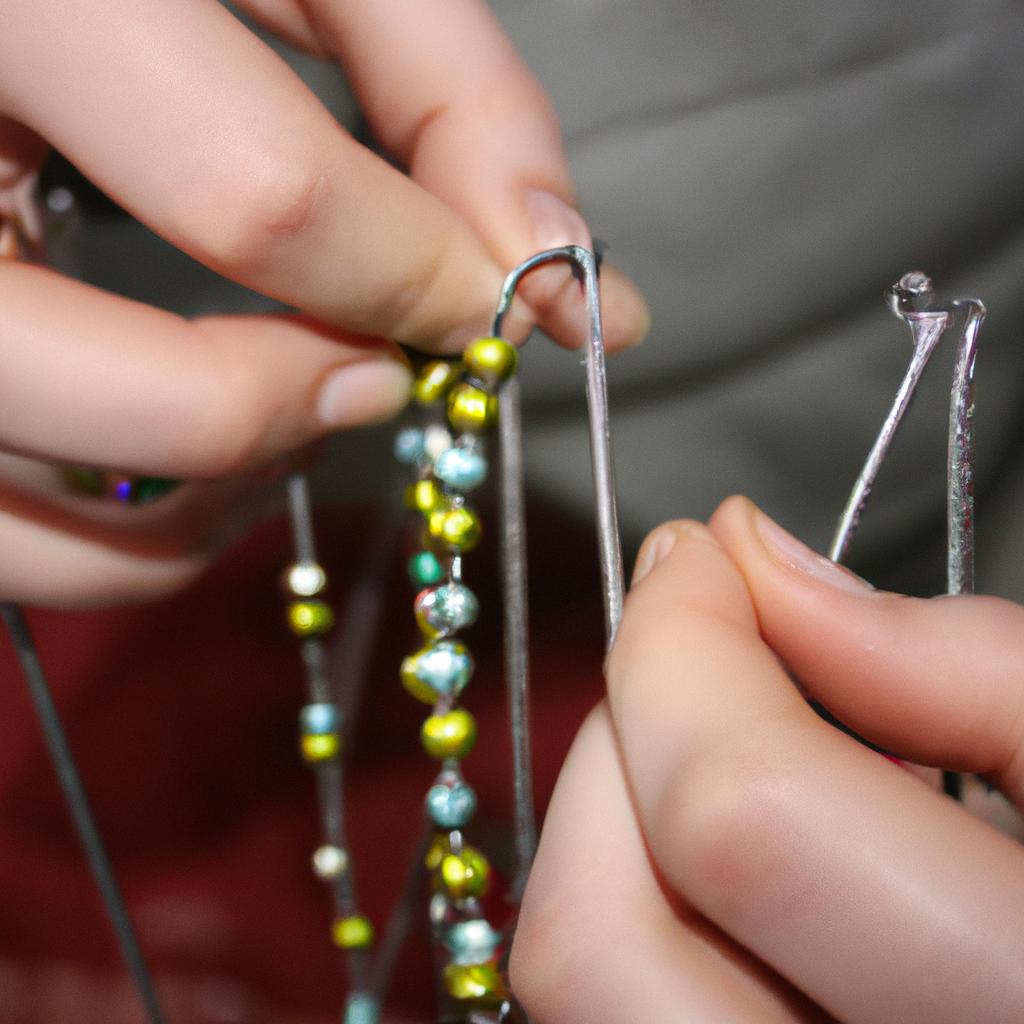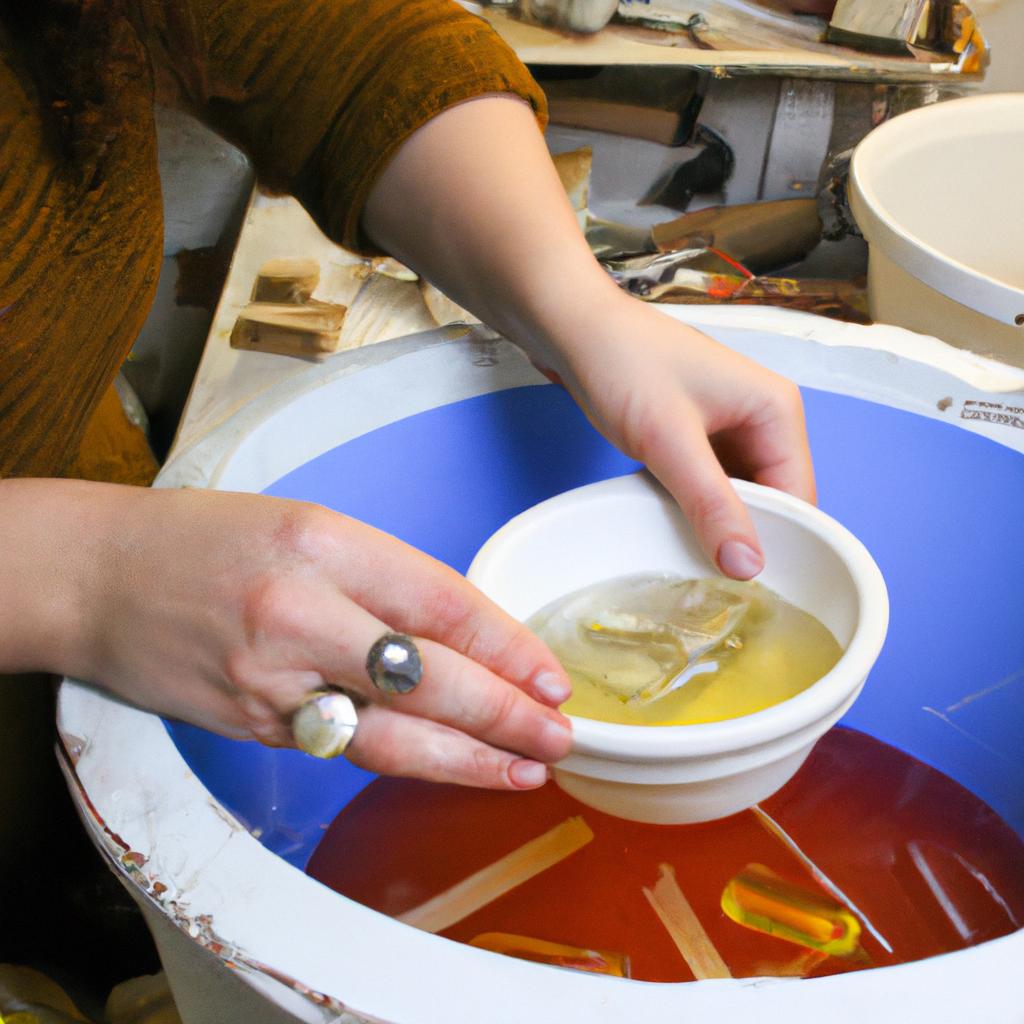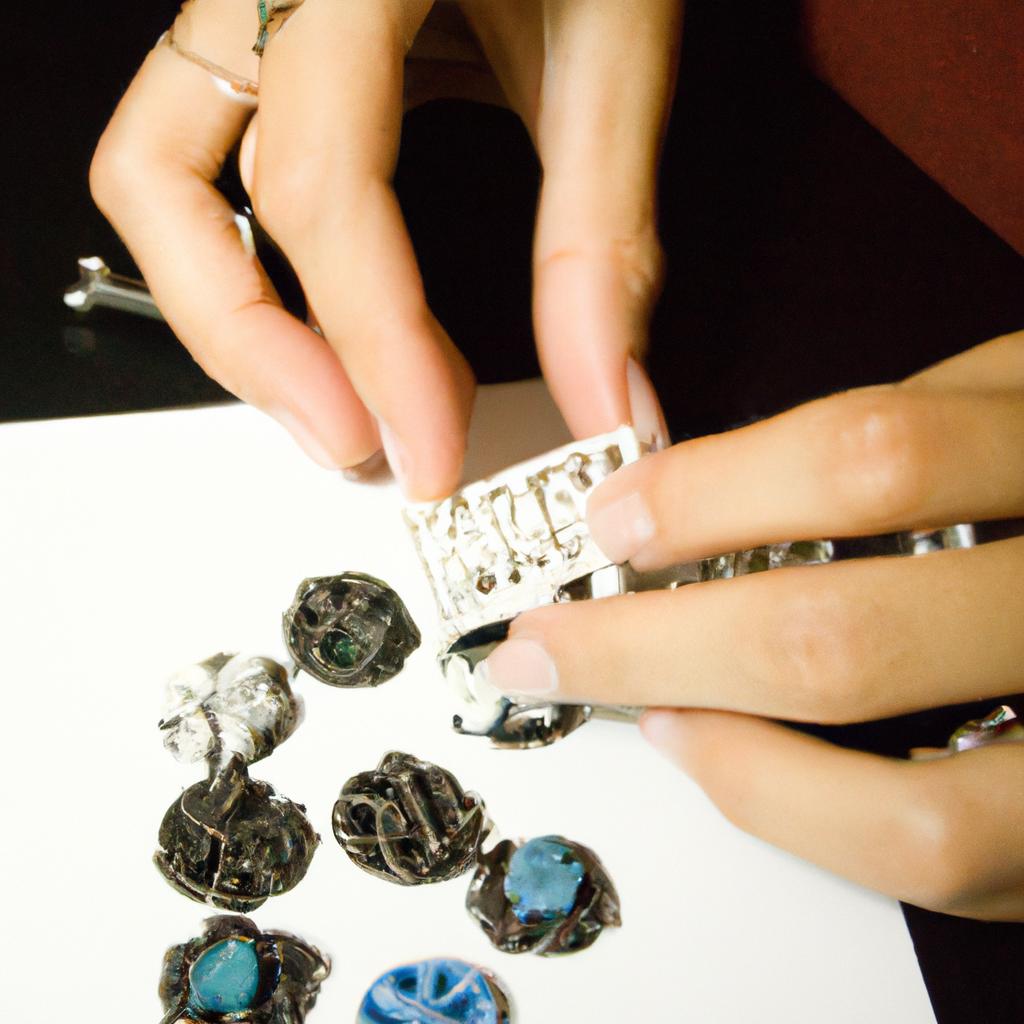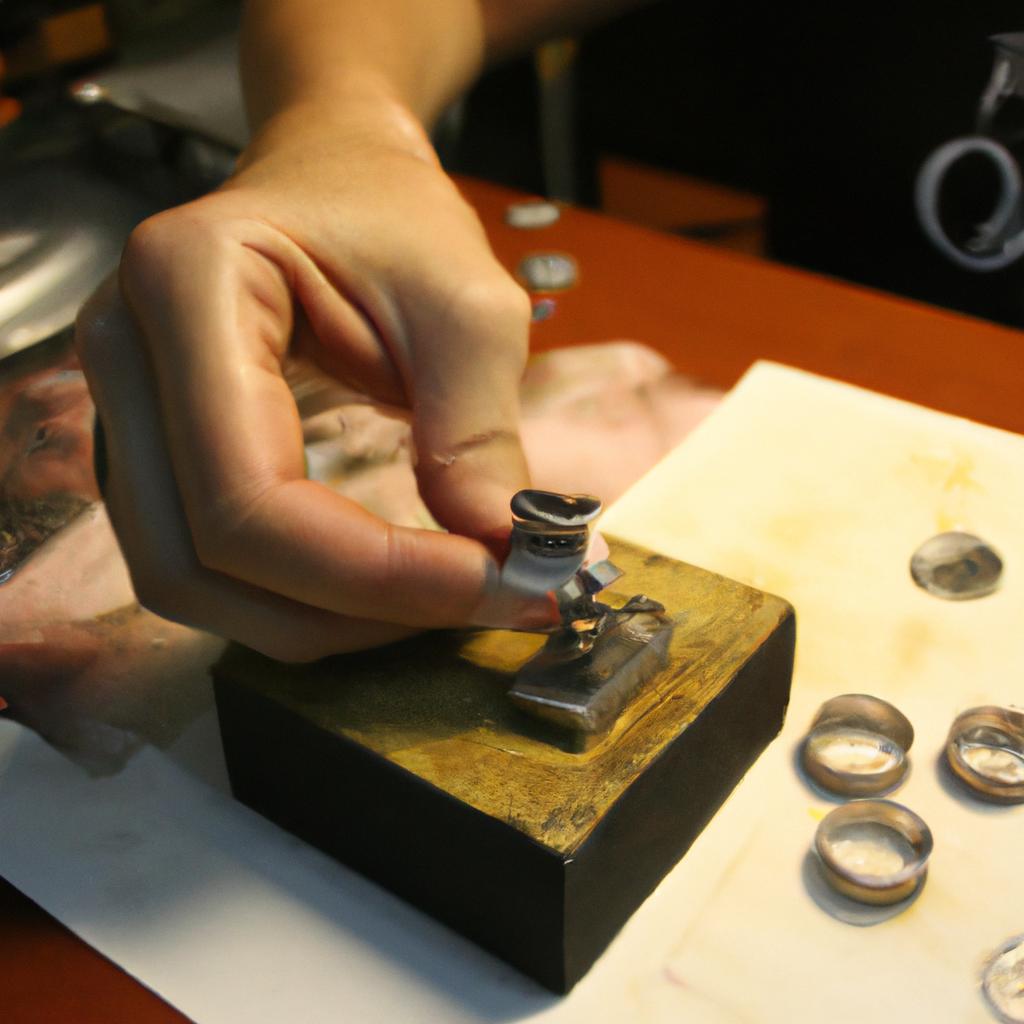In the ever-evolving world of jewelry making, one technique that has stood the test of time is chainmaille. Dating back centuries, this intricate art form originated as a means of creating armor to protect warriors in battle. However, over time it has transformed into a captivating method for crafting stunning pieces of wearable art. This comprehensive guide aims to explore the history, techniques, and versatility of chainmaille jewelry making.
Imagine a delicate necklace adorned with intricately woven metal rings, catching the light as it gracefully drapes around your neck. Such masterpieces are not merely products of chance or luck; they are meticulously crafted through the ancient craft of chainmaille. By linking countless tiny metal rings together in specific patterns, artisans can create a wide array of visually striking designs that range from simple elegance to bold statements. Though often associated with medieval aesthetics, chainmaille has transcended its origins and gained popularity across various styles and cultures.
This article delves deep into the world of chainmaille jewelry making by exploring its historical roots and evolution, examining various weaving techniques employed by skilled artisans, and showcasing examples of how these creations can be incorporated into contemporary fashion trends. Whether you are an experienced jeweler looking to expand your skillset or an enthusiastic beginner looking to delve into the world of jewelry making, this guide is here to provide you with the knowledge and inspiration you need.
To get started in chainmaille jewelry making, it’s essential to understand the historical significance of this craft. Chainmaille originated as a form of armor, providing protection for warriors on the battlefield. The interlocking metal rings created a flexible yet durable barrier against weapons. Over time, however, chainmaille began to be appreciated for its aesthetic qualities as well.
The technique involves meticulously linking individual rings together using various weaving patterns. These patterns can create different textures and designs, allowing artisans to explore their creativity and bring unique visions to life. From simple weaves like European 4-in-1 or Byzantine to more complex designs such as Dragonscale or Full Persian, there are endless possibilities for creating stunning chainmaille pieces.
In addition to traditional metals like steel or bronze, modern chainmaille artists have expanded their material choices to include precious metals like silver and gold, as well as colorful anodized aluminum or vibrant rubber rings. This versatility allows for even more creativity when designing jewelry pieces.
Chainmaille jewelry has found its place in contemporary fashion trends by adapting traditional techniques to fit modern aesthetics. Delicate chainmaille necklaces and bracelets can add a touch of elegance to any outfit, while bolder statement pieces can make a captivating focal point. Mixing different metals or combining chainmaille with other jewelry-making techniques like wire wrapping or beadwork opens up even more possibilities for customization.
Whether you’re interested in creating timeless classics inspired by medieval history or pushing the boundaries of design with innovative combinations of materials and weaving patterns, chainmaille jewelry making offers something for everyone. With practice and dedication, you can master this intricate art form and create your own wearable works of art.
So whether you’re a seasoned jeweler looking to expand your skillset or a beginner eager to embark on a new creative journey, let this guide be your companion as you explore the fascinating world of chainmaille jewelry making. From its historical roots to its modern-day applications, there’s no doubt that this ancient craft will continue to captivate and inspire for generations to come.
History of Chainmaille
History of Chainmaille
Chainmaille, a technique used to create intricate woven metal jewelry, has a rich and fascinating history. Its origins can be traced back to ancient times, where it served various purposes beyond adornment. One such example is the use of chainmaille armor by medieval knights for protection on the battlefield.
To fully appreciate the significance of chainmaille, it is essential to understand its historical context. This craft originated in regions such as Ancient Egypt, India, and Persia, with each culture developing unique techniques and styles. For instance, the Persian artisans crafted delicate chainmaille patterns known as “four-in-one” weave using small rings made from precious metals like gold or silver.
The artistry and craftsmanship involved in creating chainmaille have evolved over centuries. Here are some key points that highlight the profound impact of this technique:
- Intricate Weave Patterns: The beauty of chainmaille lies not only in its durability but also in its aesthetic appeal. Artisans meticulously interweave individual metal rings into stunning patterns and designs.
- Historical Significance: Chainmaille played a crucial role throughout history as a form of protection during battles and conflicts. It provided warriors with vital defense against weapons such as swords or arrows.
- Cultural Heritage: Different cultures embraced chainmaille in their own unique ways, incorporating distinct materials and weaving techniques passed down through generations.
- Modern Revival: While once primarily associated with armor-making, chainmaille experienced a revival in modern times as an art form and jewelry-making technique cherished by enthusiasts worldwide.
| Intricate Weave Patterns | Historical Significance | Cultural Heritage | |
|---|---|---|---|
| Description | Elaborate designs created through meticulous interweaving of metal rings | Vital protective gear used by warriors throughout history | Unique interpretation embedded within different cultural practices |
| Emotional Response | Awe and admiration for the craftsmanship involved in creating intricate patterns | Fascination with the historical context, appreciating its importance | Appreciation of diverse cultures and their artistic traditions |
As we delve into the subsequent section on “Types of Chainmaille Weaves,” it becomes evident that chainmaille is not only a craft but also an art form that has stood the test of time. By exploring different weaving techniques, one can gain a deeper understanding of this ancient tradition’s versatility and enduring appeal.
Transitioning seamlessly to the next section…
Moving beyond the historical background, let us now explore the fascinating world of various chainmaille weaves and discover how they contribute to creating stunning pieces of jewelry.
Types of Chainmaille Weaves
Section Title: Exploring the Intricate Art of Chainmaille Weaving
As we delve deeper into the world of chainmaille, it becomes evident that there are various types of weaves used to create intricate jewelry pieces. One such weave is the Byzantine weave, characterized by its interlocking spiral pattern. Let’s explore some of the most popular and visually captivating chainmaille weaves.
Types of Chainmaille Weaves
- European 4-in-1: This classic weave consists of a simple repetition of four rings linked together in a square formation. Its versatility allows for endless design possibilities, making it a favorite among beginners and experienced artisans alike.
- Box Chain: Also known as “Celtic” or “Queen’s Link,” this weave features alternating links that form neat rows, creating an elegant appearance reminiscent of woven boxes. The Box Chain is often showcased in necklaces and bracelets due to its graceful drape.
- Full Persian: With its dense and tightly-knit structure, the Full Persian weave offers strength and durability while exuding an aura of sophistication. This complex weave requires meticulous attention to detail but rewards crafters with stunning results.
- Dragon Scale: Aptly named after its resemblance to dragon scales, this intricate weave pairs small rings with larger ones, resulting in a unique texture that catches light beautifully. Dragon Scale creations are highly sought-after for their visual impact and tactile charm.
To better understand the variations within each weave type, consider the following table:
| Weave | Difficulty Level | Visual Appeal | Popular Applications |
|---|---|---|---|
| European 4-in-1 | Easy | ★★★★ | Bracelets, Necklaces |
| Box Chain | Moderate | ★★★ | Chokers, Earrings |
| Full Persian | Difficult | ★★★★ | Bracelets, Pendants |
| Dragon Scale | Advanced | ★★★★★ | Statement Necklaces, Cuffs |
Exploring the world of chainmaille weaves offers a captivating journey into artistic expression. The intricate patterns and designs created through these weaves showcase the beauty of this ancient craft. In our next section, we will discuss the essential tools and materials needed to embark on your own chainmaille jewelry-making adventure.
[Transition]Before diving into creating stunning chainmaille pieces, it is crucial to gather all the necessary tools and materials.
Tools and Materials Needed for Chainmaille
Chainmaille Weaves: Exploring the Endless Possibilities
Imagine creating a stunning piece of jewelry that not only catches the light but also stands as a testament to your creativity and craftsmanship. Chainmaille weaves offer an array of intricate patterns, allowing you to bring your artistic vision to life through this ancient craft. With their origins dating back centuries, these weaves have evolved into countless variations, each offering its own unique aesthetic appeal.
There are numerous types of chainmaille weaves available for aspiring jewelry makers to explore. From classic European weaves like Byzantine and Box Chain to more complex Japanese-inspired designs such as Dragonscale and Full Persian, the possibilities are endless. Each weave has distinct characteristics, including different levels of difficulty and visual impact. By understanding the various options at your disposal, you can select the perfect weave for your desired project.
When venturing into the world of chainmaille jewelry making, it’s essential to equip yourself with the right tools and materials. To ensure smooth and efficient weaving processes, consider investing in quality pliers specifically designed for chainmaille work. These pliers typically feature flat or curved jaws with rounded edges to prevent scratching or damaging delicate metal rings. Additionally, having a variety of ring sizes and materials on hand allows for greater versatility when experimenting with different weaves.
To grasp the significance of choosing suitable tools and materials effectively, let us delve deeper:
-
Tools:
- Flat-nose Pliers
- Bent-nose Pliers
- Jump Ring Opener
- Wire Cutters
-
Materials:
- Stainless Steel Rings (18-gauge)
- Anodized Aluminum Rings (20-gauge)
- Bronze Rings (16-gauge)
- Copper Rings (22-gauge)
By having access to these essential tools and materials along with a solid understanding of chainmaille weaves, you can confidently embark on your jewelry-making journey. In the subsequent section, we will guide you through a step-by-step process for creating exquisite chainmaille jewelry pieces that reflect your artistic flair and attention to detail. So let’s dive in and explore the captivating world of crafting with metal rings.
Step-by-Step Guide to Creating Chainmaille Jewelry
As you hold up your finished piece, a stunning bracelet adorned with intricate rings woven together in an elegant pattern, you can’t help but feel a sense of accomplishment. But what exactly makes these patterns and weaves so captivating? In this section, we will delve into the world of chainmaille patterns and explore their intricacies.
One example of a popular chainmaille weave is the Byzantine weave. This weave consists of interlocking rings that create a visually appealing pattern reminiscent of ancient Roman architecture. The tightness or looseness of the weave can be adjusted to achieve different effects, allowing for endless possibilities in designing unique jewelry pieces.
To truly understand chainmaille patterns, it is essential to grasp some key concepts:
- Ring size: Different ring sizes can dramatically change the look and feel of a weave. Experimenting with various ring sizes opens up new design opportunities.
- Aspect ratio: This refers to the relationship between the inner diameter of a ring and its wire thickness. Understanding aspect ratios helps determine whether rings will fit together properly within a specific pattern.
- Expansion and contraction: Some weaves naturally expand or contract when pulled in certain directions. Being aware of these characteristics allows for more precise control over the final shape and structure.
- Discover the joy of creating complex designs from simple metal rings.
- Experience the satisfaction of mastering intricate weaving techniques.
- Unleash your creativity by experimenting with different colors and textures.
- Share your handmade treasures as meaningful gifts or wearable art.
Now, let’s take a closer look at how different chainmaille weaves compare to each other:
| Weave | Difficulty Level | Usage |
|---|---|---|
| Byzantine | Moderate | Bracelets, necklaces |
| European 4-in-1 | Easy | Armor, jewelry |
| Full Persian | Difficult | Necklaces, earrings |
| Japanese 12-in-2 | Very difficult | Decorative pieces |
As you can see from the table above, each weave presents its own challenges and possibilities. The difficulty level may vary depending on your skill level and patience while working with intricate patterns.
With an understanding of chainmaille patterns and weaves under your belt, you are now prepared to embark on the next step in your journey towards mastering this ancient craft. In the following section, we will share valuable tips and tricks that will elevate your chainmaille creations to new heights. Get ready to take your skills to the next level as we delve into the realm of advanced techniques and innovative designs.
Tips and Tricks for Mastering Chainmaille
Having gained a solid understanding of the step-by-step process involved in creating chainmaille jewelry, we can now delve into some valuable tips and tricks that will help you master this intricate craft. By incorporating these techniques into your practice, you’ll be able to take your chainmaille creations to new heights of complexity and artistry.
Tips and Tricks for Mastering Chainmaille:
-
Experiment with Different Materials: While traditional chainmaille is often made using metal rings, don’t limit yourself to just one type of material. Consider exploring various options such as rubber, leather, or even unconventional materials like paper or fabric. This experimentation will not only add uniqueness to your designs but also allow you to create pieces suitable for diverse occasions.
-
Vary Ring Sizes and Gauges: The size and gauge of the rings used in chainmaille play a crucial role in determining the final appearance and structure of the piece. Try experimenting with different ring sizes and gauges to achieve desired effects. Using smaller rings creates more intricate patterns, while larger rings result in bold statement pieces.
-
Incorporate Colorful Accents: Don’t hesitate to introduce vibrant colors into your chainmaille designs by adding beads or other ornaments between the links. This technique allows you to infuse personality into your work and create eye-catching jewelry that stands out from the crowd.
- Unlock endless creative possibilities through material experimentation.
- Discover unique patterns by varying ring sizes and gauges.
- Elevate your designs with colorful accents.
- Develop a signature style that reflects your individuality.
Table Example:
| Material | Advantages | Disadvantages |
|---|---|---|
| Metal | Durable | Heavy |
| Rubber | Lightweight | Less formal |
| Leather | Versatile | Requires care |
| Fabric | Soft | Limited durability |
Exploring Advanced Chainmaille Techniques:
As you become more proficient in the art of chainmaille, it’s natural to seek further challenges and expand your repertoire. By mastering these techniques, you’ll be able to create intricate patterns, incorporate gemstones, and even explore contemporary applications of this ancient craft.
[Next Section: Exploring Advanced Chainmaille Techniques]Exploring Advanced Chainmaille Techniques
Building upon the foundational knowledge and practical tips shared in the previous section, this next segment delves into advanced chainmaille techniques that will allow you to elevate your jewelry-making skills. By incorporating these techniques into your repertoire, you can create intricate designs that truly stand out.
To illustrate the potential of advanced chainmaille techniques, let’s consider a hypothetical scenario. Imagine crafting a statement necklace adorned with brightly colored glass beads. By employing an advanced technique known as “captured bead weaving,” you can seamlessly incorporate these delicate elements into your chainmaille design. This method involves carefully threading each individual bead onto specific rings before interlocking them with other rings, resulting in a visually stunning piece that effortlessly blends metalwork and beading.
When venturing into more complex chainmaille projects, it is crucial to approach them with patience and precision. Here are some key considerations to keep in mind:
- Experimentation is key: Embrace the opportunity to push boundaries and explore new patterns or combinations of weaves.
- Attention to detail matters: Take extra care when closing rings to ensure they align perfectly, avoiding gaps or misalignments.
- Practice makes perfect: Just like any craft, mastering advanced chainmaille techniques requires practice and commitment. Allow yourself time to hone your skills through frequent repetition.
- Seek inspiration from fellow artisans: Engage with online communities or attend local workshops where you can learn from experienced chainmaillers who have already mastered these techniques.
In addition to these points, referring to visual aids can greatly enhance understanding and inspire creativity during the learning process. The table below showcases four popular advanced weaves along with their corresponding difficulty levels:
| Weave Name | Difficulty Level |
|---|---|
| Byzantine | Intermediate |
| Dragonscale | Advanced |
| Full Persian | Expert |
| Helm | Intermediate |
By incorporating these advanced chainmaille techniques into your repertoire, you can take your jewelry-making skills to new heights. Remember, the journey towards mastering these intricate designs may be challenging at times, but with perseverance and a willingness to learn from others, you will undoubtedly create stunning pieces that capture attention and admiration.
(Note: The term “Byzantine” refers to a specific weave pattern commonly used in chainmaille jewelry making.)
 Shanes Jewelry
Shanes Jewelry



